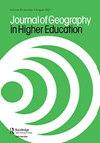The Virtual Palaeosciences (ViPs) project: resources for online learning in or out of a pandemic
IF 1
4区 教育学
Q2 EDUCATION & EDUCATIONAL RESEARCH
引用次数: 2
Abstract
The Virtual Palaeosciences (ViPs) project is a collaborative initiative bringing palaeoscientists together to locate, access and share online educational resources (OERs). It began as a response to the 2020 shift to online learning when the COVID-19 pandemic curtailed field and lab work. We outline the development and initial outcomes of the project and consider future directions post-pandemic. Our initial focus was to create a searchable list of OERs (now numbers 600+). The project has also promoted co-operation across institutions and created new collaborations. It became clear that even experienced and teaching-focused educators were anxious about how to incorporate virtual materials and develop alternatives to field and laboratory work and deliver their intended learning outcomes. ViPs aim to become a “hub” for palaeoscience teaching resources. While some face-to-face teaching has returned in Higher Education, the benefits of online elements have become clear to students and educators alike. Therefore, following the pandemic, an increasing shift towards a blended delivery with greater use of OERs in palaeoscience and other disciplines is likely. Longer term, the ViPs project also seeks to increase inclusive, accessible education in the palaeosciences through the digital enhancement of provision, by supporting both users and creators of virtual teaching materials. [ FROM AUTHOR] Copyright of Journal of Geography in Higher Education is the property of Routledge and its content may not be copied or emailed to multiple sites or posted to a listserv without the copyright holder's express written permission. However, users may print, download, or email articles for individual use. This may be abridged. No warranty is given about the accuracy of the copy. Users should refer to the original published version of the material for the full . (Copyright applies to all s.)虚拟古科学(ViPs)项目:疫情内外的在线学习资源
虚拟古科学(ViPs)项目是一项合作倡议,将古科学家聚集在一起,定位、访问和共享在线教育资源(OER)。它最初是为了应对2020年向在线学习的转变,当时新冠肺炎疫情限制了现场和实验室工作。我们概述了该项目的发展和初步成果,并考虑了疫情后的未来方向。我们最初的重点是创建一个可搜索的OER列表(现在的数字是600+)。该项目还促进了各机构之间的合作,并创造了新的合作。很明显,即使是经验丰富、注重教学的教育工作者也对如何结合虚拟材料、开发实地和实验室工作的替代品以及实现预期的学习成果感到焦虑。ViPs旨在成为古科学教学资源的“枢纽”。虽然高等教育中又恢复了一些面对面的教学,但学生和教育工作者都清楚地看到了在线元素的好处。因此,在新冠疫情之后,可能会越来越多地向混合交付转变,在古科学和其他学科中更多地使用OER。从长远来看,ViPs项目还寻求通过数字增强提供,支持虚拟教材的用户和创作者,来增加古科学领域的包容性、可及性教育。[发件人]《高等教育地理杂志》的版权归Routledge所有,未经版权持有人明确书面许可,不得将其内容复制或通过电子邮件发送到多个网站或发布到listserv。但是,用户可以打印、下载或通过电子邮件发送文章供个人使用。这可能会被删节。对复印件的准确性不作任何保证。用户应参考材料的原始发布版本以获取完整信息。(版权适用于所有人。)
本文章由计算机程序翻译,如有差异,请以英文原文为准。
求助全文
约1分钟内获得全文
求助全文
来源期刊

Journal of Geography in Higher Education
Multiple-
CiteScore
5.80
自引率
9.50%
发文量
29
期刊介绍:
The Journal of Geography in Higher Education ( JGHE) was founded upon the conviction that the development of learning and teaching was vitally important to higher education. It is committed to promote, enhance and share geography learning and teaching in all institutions of higher education throughout the world, and provides a forum for geographers and others, regardless of their specialisms, to discuss common educational interests, to present the results of educational research, and to advocate new ideas.
 求助内容:
求助内容: 应助结果提醒方式:
应助结果提醒方式:


